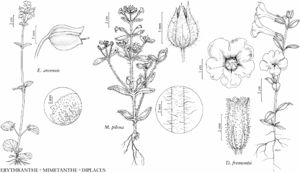Mimetanthe pilosa
Bull. Calif. Acad. Sci. 1: 181. 1885.
Annuals fibrous-rooted or taprooted, often becoming woody; stems, leaves, and pedicels villous with mixture of minute (0.1–0.2 mm) stipitate or sessile-glandular hairs and longer (0.5–1.5 mm), multicellular, flattened, vitreous hairs. Stems simple or much-branched, 2–35 cm. Leaves 12–50 (–90) × 3–15 mm; petiole 0–1 mm; blade narrowly elliptic to oblanceolate or oblong-oblanceolate. Pedicels 9–25 (–35) mm. Flowers: fruiting calyx erect, swollen-ovoid, 5–8 mm, lobes strongly unequal, 3–4 mm, adaxial longest; corolla 6–10 mm, tube slightly exserted from calyx, expanding abruptly into limb, palate sparsely pubescent; stamens included, proximal pair sometimes reduced or essentially absent; style sessile-glandular. Capsules included or slightly exserted, ovoid-fusiform, 4–7 mm, minutely and densely pustulate-glandular.
Phenology: Flowering Apr–Aug(–Sep).
Habitat: Sandy and gravelly stream banks, sandy streambeds and washes, sandstone seeps.
Elevation: (500–)700–2000(–3000) m.
Distribution
Ariz., Calif., Idaho, Nev., Oreg., Utah, Wash., Mexico (Baja California), Mexico (Baja California Sur)
Discussion
Selected References
None.
